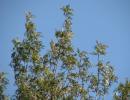
|
Silky-oak
Scientific name:
Grevillea Robusta
Order/Family:
Proteaceae
Local names:
Kamba (Mukima); Kikuyu (Mubariti, Mukima); Kisii (Omokabiria); Luhya (Eshichuma, Wakhuisi); Nandi (Kapkawet).
|
Introduction
|
General Distribution:
The Grevillea robusta originated from Australian and is widely used in Africa.
General Information about the Tree: Some communities believe the species attracts lightning in homesteads. However, it is an extremely important tree in the Kenyan highlands and has become an integral part of the farming system in many areas.
Biophysical Limits: Altitude ranges between 0 and 3000 meters above sea level.
It does well on neutral to acidic loam or light sandy soils but is not tolerant to waterlogging or heavy clays. Found in Agro-ecological zones II - V
|
Propagation and Tree Management:
Grevillea .spp may be propagated by use of wildings or seedlings.
Pollarding, lopping, coppicing and pruning optimize their benefits if used in managing them.
Note; only young trees coppice well Maturity takes 6 yrs for poles and 30 yrs for timber
Products:
- Apiculture: The golden flowers are attractive to bees, hence an important honey plant.
- Fuel: G. robusta is popular for firewood and charcoal. It is also used to fuel locomotives and river steamers, power boilers and small industries.
- Fibre: Mean fibre length is about 1.5 mm and width about 26 micrometer; the wood is suitable for pulping.
- Timber: its timber has economic potential; it can be used in making railroad ties, plywood, panelling, air-freight cases and furniture, parquetry, turnery, boat building, interior trim, cabinet work, parquet flooring, boxes, toys and novelties.
- Gum or resin: G. robusta gums are soluble, viscous and relatively high resistant to hydrolysis, they may therefore have some industrial applications.
- Poison: The flower buds, fruit and seeds are cyanogenic. Through contact with the leaves, sensitive persons may develop contact dermatitis due to tridecylresorcinol, a chemical compound related to the allergen toxicodendron.
Services:
- Shade or shelter: This is a well known shade tree in coffee and tea plantations. Its spreading branching system makes it ideal for windbreaks or shelterbelts against wind-induced mechanical damage, high rates of transpiration and surface evaporation.
- Reclamation: G. robusta is a pioneering colonizer of disturbed sites.
- Soil improver: G. robusta provides abundant quantities of leaf mulch, which may accumulate to a depth of 30-40 cm. This thick layer protects the soil and aintains soil temperature. The leaves and twigs are apparently rich in aluminum.
- Ornamental: Its majestic height, attractive shape and beautiful foliage make G. robusta an ideal tree for landscaping of private and public gardens. The cut leaves are used in flower arrangements, and young plants are grown as indoor pot plants in Europe.
- Intercropping: A deep rooting system causes little interference with shallow-rooted crops, and it can be successfully intercropped with banana, tomato and other agricultural crops.
Pests and Diseases:
In humid regions, G. robusta is vulnerable to attack by fungal diseases such as Corticium salmoniclor. Fungi such as Amphichaeta grevilleae, Cercospora spp. and Phyllostica spp. have been observed to cause considerable damage to leaves and stems of young plants in Sri Lanka, particularly if they are over watered in the nursery. Under lowland conditions in the Caribbean, it is severely attacked by the scale insect Asterolecanium pustulans. Attack by termites can be a problem when planted on dry sites in Africa. In Peninsular Malaysia, the big white ant Termes gestroi destroyed experimental trees. The wood is susceptible to marine borer and pinhole borer. Sapwood is susceptible to Lyctus.
Information Source Links
- Maundu P. and Bo Tengnas. (2005). Useful trees and shrubs for Kenya, World Agroforestry Centre. ISBN-9966-896-70-8.
- www.worldagroforestrycentre.org

 Back
Back

